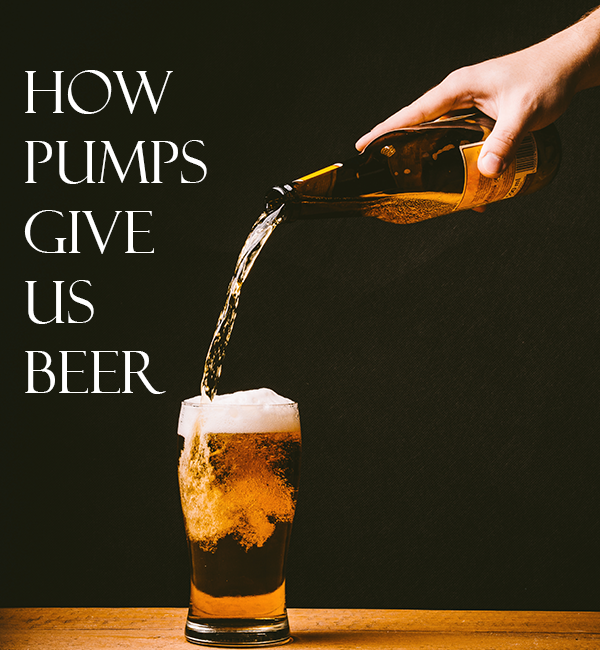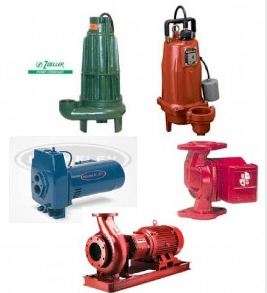-
How Pumps Make Quality Draft Beer Possible
March 16, 2018Happy Saint Patrick’s Day (weekend)! Also known as the holiday where overgrown people from their mid-20s to late 30s try to relive their college years by getting belligerently drunk and violent. Good times! I’ve written a little bit about the history of Saint Patrick’s Day in the past. This time, I want to tie the history of this most enjoyable of holidays into pumps. Without pumps it would be much more difficult to enjoy the magical elixir we most closely associate with this holy day: beer. Here’s a very special edition of Pumps Make It Possible. How Beer Gets Made Of course, before the beer can get pumped into your glass, brewers actually have to, you know, make the beer. Whether you consider yourself a craft beer connoisseur who only imbibes IPAs or a weekend warrior who just likes to throw back a few cold ones with the boys, you have probably given at least some thought as to how you get your tasty beer. You know it involves hops and grains and the vagaries of something called the 'fermentation process,' but how exactly does it all fit together It's actually a pretty straightforward process that dates all the way back to ancient Egypt and Mesopotamia. Perhaps the famous "Egyptian walk", was created when Hotep was drunk during the equivalent of a St. Paddy's day celebration. Cereal grains (most commonly barley) with certain sugars are the base ingredient. The grain is malted, a multi-step process in which it is soaked in water, spread on a floor for a few days and then dried at a high temperature for hours. The grain is milled and then mixed with hot water in a process known as mashing. The purpose of the mashing is to create sugars for fermenting. The liquid is then moved to a tank or kettle where it is boiled with hops. The hops add the bitter taste that offsets the natural sweetness of the milled grain. The liquid is then cooled in a heat exchanger before yeast is added. The liquid (also called a "wort" at this stage) then goes into a fermentation tank where more yeast is added. After fermenting and conditioning for a set period, the beer is then carbonated, filtered and stored. It is now ready to drink. The entire process is a little more complicated then that and modern techniques may vary by brewer, but for our purposes, those are the basics. First We Feast, did an interesting step-by-step guide with animations if you want a more detailed look. But what about the pumps How Pumps Give Us Beer As with any other type of fluid, whether it be groundwater or wastewater, beer at rest needs to be compelled to move from its source, typically a casket or keg. But unlike with water transport, the liquid is meant to retain something of its original state. Taste, flavor and freshness are paramount, particularly in a draft beer system. That is why home brewers and barkeeps alike make sure they have a quality beer pump to transport the beer to the tap in such a way that it still tastes great in your glass. Beer pumps are powered by compressed air or high pressure gas (such as CO2) which acts as a propelling force to move the beer. The gas that powers the pump and the gas that actually comes into contact with the beer, are separate. Note that excess CO2 should be properly vented. Brewers will often set a preferred PSI pressure rating which is ideal for moving beer without effecting the carbonation level or spoiling the beer. Depending on the necessary configuration of pump and keg, the beer can be moved in runs that are either long or short, horizontal or vertical. The important thing is that you use the correct pressure setting for moving the beer. Also make sure all fittings are tightly attached and that the beer lines are periodically cleaned. Goulds Water Technology makes beer pumps and PumpProducts.com might be adding some in the future. In the meantime, I hope you now have an appreciation for how important the humble pump is for giving you something that you probably enjoy with great enthusiasm. Just when you thought pumps were boring. Here's to beer, the cause of (and solution to) all of life's problems. Plus let's not forget, here's to the pumps that make it possible. Enjoy the holiday. Do you have any ideas for future editions of "Pumps Make It Possible" Let us know in the comments. Pump Products sales specialists are standing by to help you find the right pump or part, as well as to provide price quotes, stocking availability and shipping information. Call our toll free number 1-800-429-0800 to speak to an expert today.
-
Inspector Pumphead’s FAQ: Well Pump Edition
May 23, 2017Welcome to Inspector Pumphead’s Frequently Asked Questions! I will be answering some of the most common questions we get on a specific topic. Some of this information may also be available elsewhere, but this feature will serve as a convenient one-stop source. In this edition, I'll talk about well pumps. Well Pump FAQ 1. Why are there two different types of well pumps listed What’s the difference between ‘jet’ and ‘submersible’ Jet well pumps are surface pumps configured above the well system, while a jet assembly system (twin pipe or Packer depending on the application) is inserted into the well shaft. The main components of a jet pump are a nozzle, venturi and the jet itself. The physics and mechanics of it are interesting, but we’ll focus on the basics here: these components work together to create a vacuum above the water, which allows atmospheric pressure underneath to push the water upwards. Jet pumps can be either horizontally or vertically configured and are much the same size and shape as other pumps. Submersible well pumps are actually installed and submerged under water at the base of the well. Whereas jet pumps use suction to pull water, submersible pumps create pressure to push the water in an upward direction. Submersible well pumps are cylindrical and “thin” in diameter so as to easily fit down a well shaft. They are often tall as well since submersible well pumps usually contain multiple stages stacked on top of each other. A stage is simply a compartment with an impeller, diffuser and upthrust washer that increases the pressure as water moves up through each stage. The more stages, the higher the head. 2. So which one is better As is always the case when it comes to pumps, the answer is “it depends on your system and application.” Submersible pumps are more efficient, especially in deeper wells. The farther the pump is away from the water table, the less effective it will be. Since submersible well pumps are closer to the source, they are more reliable. The downside to a submersible pump is that it must be pulled out for maintenance, repair or replacement. Being submerged also exposes the pump to contaminants such as sand. 3. What constitutes a ‘deep well’ or ‘shallow well’ The depth of the well refers specifically to the depth of the water table, which is the top of the reservoir. A water table 25 ft. or fewer underground, while any water table deeper than 25 ft. is considered a deep well. 4. What is a convertible jet pump A convertible jet pump is a pump that can be configured for either shallow well or deep well applications with the proper fittings. Convertible jet pumps are often built as deep well jet pumps and include a bolt on shallow well adapter. Deep well fittings, such as the jet assembly (twin pipe or Packer) are usually purchased separately. 5. Why would I need a convertible pump Shouldn’t I just get either a deep well or shallow well pump Usually you’d be able to stick with either one or the other type of jet well pump. In some areas, however, water tables may fluctuate due to the climate, unique elevation, topography changes or other factors. A convertible jet well pump ensures that you will be prepared and will continue to receive well water in such a case. Pump Products application engineers are standing by to help you find the right pump, as well as to provide price quotes, availability and shipping information. Call our toll free number 1-800-429-0800.
-
PUMP BUYERS GUIDE
February 6, 2013Because they tend to operate out of sight, the pumps we use every day often go unnoticed. It isn't until we experience a breakdown and need to replace a pump that’s necessary to wash clothes, heat our home or drain a flooded basement that most of us realize how little we know about pumps and how to evaluate them. KEY TERMS TO UNDERSTAND WHEN CHOOSING A PUMP PUMP SPECIFICATIONS PRESSURE - The force delivered at a given point in a pump’s discharge line, usually measured in pounds per square inch (psi). LIFT - The number of feet that fluid needs to be lifted for removal. Correctly sizing a pump for lift is important for that pump's longevity and energy efficiency. HEAD - The height at which a pump can no longer exert enough pressure to move water. The higher the head pressure, the more powerful a pump is. FLOW - The volume of liquid a pump can move. The objective is to achieve the best possible balance between the size of the outflow pipe and the speed at which you want fluid to flow through it. POWER SOURCES When choosing a pump it's important to consider your energy source. Most pumps are manufactured to run on one of the following power sources: Electricity - The vast majority of pumps are electrically powered. Gasoline - Gas-powered pumps are often portable and employed in situations where electrical power has failed or is absent. Diesel - Applied much as gas-powered pumps are, though diesel fuel generally offers better fuel efficiency than gas. Water - Water powered pumps run on a home or municipal water supply and will operate as needed for an unlimited amount of time. Compressed Air - Air operated pumps are positive displacement pumps driven by compressed air. They are used in a wide range of applications. Sunlight - Solar powered pumps are ideal for sunny areas. They are clean, energy efficient and usually require very little maintenance. MATERIALS The life of a pump depends on the ability of the materials it is made from to withstand the demands of the pumping environment. Pumps are available in a variety of materials suited to varied conditions: Metals (bronze, cast iron, stainless steel) are a commonly used for pumps that operate in conditions requiring durability, resistance to high temperatures or abrasive resistance. Non-metals (thermoplastics, composites) are useful for applications requiring chemical or corrosion resistance. PUMP TYPES After you determine the pressure, lift, head and flow demands you will be putting on a pump, you can choose from a variety of configurations suited to different applications. Submersible Pumps are designed to work while immersed in the fluid they are moving. A sump pump is a common type of submersible pump, as are grinder and shredder pumps. Centrifugal Pumps employ an impeller to push liquids out through a system. A recirculating pump used to speed hot water to a kitchen sink or showerhead is an example of a centrifugal pump. Diaphragm Pumps house a membrane that undulates to create steady, consistent flow. The engine-driven trash pumps commonly used to remove mud, sewage and wastewater in municipal and industrial settings are often diaphragm pumps. Once performance and configuration demands are determined, you must decide on the best type of pump for your application. Click here for a comprehensive listing of common types of pumps currently on the market. Most pump manufacturers produce popular types of pumps with special features that make them especially well-suited to various conditions. SPECIAL FEATURES Self-Priming pumps require no manual supplying of fluid to the pumping chamber and are therefore easy to maintain and convenient to operate. They are ideal for tight spaces and other applications in which access is difficult or inconvenient. Adjustable Speed increases a pump's efficiency by making it adaptable to an application's changing demands. Variable speed pumps are a good choice for applications such as starter homes, which are prone to expanding performance demands. Battery Back-ups provide emergency power in the event of a power outage. Most commonly associated with sump pumps, battery backup systems are a form of low cost insurance in flood-prone applications. Alarms are designed to sound an alert when water reaches a problematic level or a pump stops working. An alarm lets you know when you should service your pump. Corrosion Resistance helps to extend the life of a pump. If a pump is placed in or around water, or moves hot or abrasive liquids, corrosion resistant construction, such as stainless steel housing and high temperature seals, will enable it to run longer and require less maintenance. These are the basics when it comes to choosing the right pump. For detailed specs, manuals and reviews on hundreds of quality pumps by top-brand manufacturers explore the many interactive pages on PumpProducts.com. For detailed specs, manuals and reviews on the pumps, pump parts and accessories we stock and ship nationally, log on to our product pages at www.pumpproducts.com or call us for details: 1-800-429-0800.
-
How To Repair a Pressure Booster Pump
August 21, 2011Pump Products sister business Pump Express goes into the field to repair and replace a pair of leaking booster pumps located in the Newark Museum. Pump Products is a stocking distributor and national service center for the world's leading manufacturers of industrial pumps and pump parts. Through our determined and factory trained professionals, we are able to provide our customers with the most innovative and cost effective products on the market today. Whether you need system advice, pump parts or a new pump, our dedicated pump experts will be able to help you with even the most complicated pump system issues. With over 500,000 sq ft of fully stocked warehouse space, we are able to ensure quick delivery times. Phone: 1-800-298-4100 Web: https://www.pumpproducts.com/index.php










